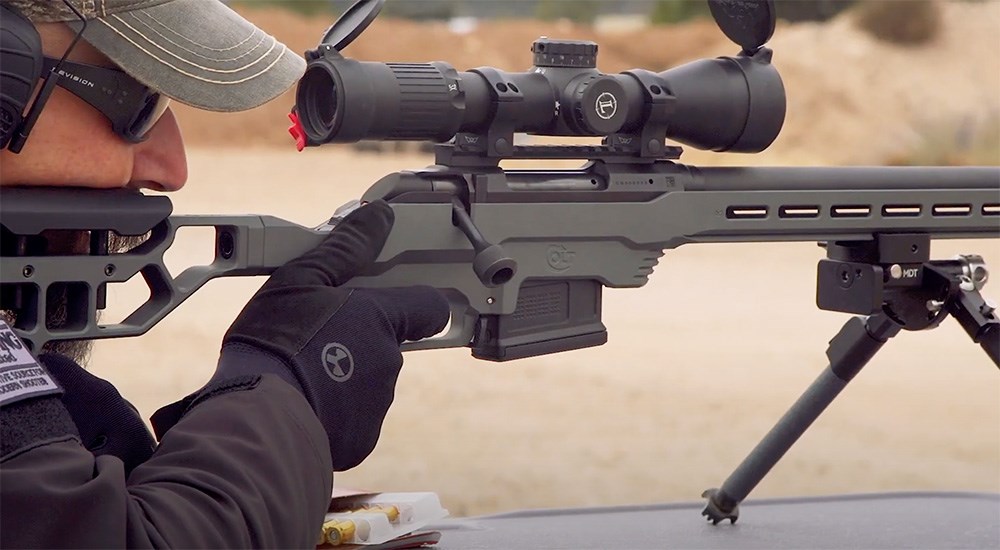In last week’s blog post, I went through the important specifications you’ll need to understand when shopping for scopes. As I alluded to at the end, though, just comparing raw numbers won’t give you the full picture—for that, you’ll need to take a closer look at the side of the box or lower down on the product page online. “First focal plane?” “Adjustable parallax?” “Fully multi-coated?” What does it all mean? Read on to find out. I’ve arranged the terms alphabetically so they’re easier to find at a glance.
Aircraft-Grade Aluminum – Meaningless marketing term. Aircraft use multiple grades of aluminum, one of which isn’t even as strong as the stuff an AR-15 receiver is supposed to be made of. Where the rubber really meets the road is standardized drop testing—even if a scope tube survives, the internal optics may be irreparably dislodged by a sharp impact.
Apo – Sometimes incorrectly capitalized, short for apochromatic lens or apochromat. An apochromatic lens is constructed in such a way that it will impart less chromatic aberration and spherical aberration to the image. Translation: it distorts the image less. No matter what kind of technology the scope uses, however, you should judge sharpness and clarity yourself by actually looking through the thing. Barring that, look for side-by-side comparisons from trusted sources online.
Bikini Cover – An rubber accessory consisting of two lens caps linked together. Rugged, waterproof, and very cheap to manufacture, a set of these comes with almost every tube-style reflex sight. Some very cheap magnified scopes also come with bikini covers in lieu of proper flip-up lens caps.
BDC – Ballistic Drop Compensation. A BDC reticle has dots or hash marks spaced below the center aiming point and calibrated to the ballistic trajectory of a particular round. That doesn’t just mean .308 Winchester, it means something like .308 Winchester 168 gr. BTHP Match at 2,700 feet per second. With the correct load from the correct barrel length, a BDC will allow you to precisely place each shot simply by using the hash mark corresponding to the target’s distance. You can use a reticle subtension diagram (found in your scope’s manual) and a ballistic calculator (available online) to make sure you’re using the BDC correctly.
BDC Cam – BDC reticles are great because they give you precise holds at various ranges. BDC cams allow you to adjust the scope itself so you don’t even need to hold over. Usually found on hunting scopes, BDC cams are interchangeable adjustment knobs which allow you to dial up and down directly for range, instead of by MOA or mils according to a ballistics chart.
Capped Turrets – See “Turrets.”
Christmas Tree – Slang term referring to a complex long-range reticle. The dots or hash marks corresponding to various combinations of range and crosswind component are arranged below the center of the crosshair in a roughly triangular shape, hence the name.
Coating – The glass lenses in firearm optics are given coatings to reduce reflection. Fully coated optics have such coatings on all glass surfaces. Multi-coated optics have multiple layers of coating on at least one surface. Fully multi-coated optics have multiple layers of coating on all surfaces. Full multi-coating is so common and cheap now that you can expect most new scopes to feature it, but you can’t use it as a proxy for glass quality. Always look through the scope yourself before buying it.
FFP/First Focal Plane – See “Focal Plane.”
Focal Plane – As a shooter, you don’t need understand the physics of how a magnified optic actually functions. Here’s the lowdown: a reticle on the second focal plane appears the same regardless of the scope’s current magnification level. A reticle on the first focal plane changes magnification with the background image, meaning when you increase the magnification, the reticle appears larger, just like the target. First focal plane scopes are usually more expensive and slightly heavier. For long-range hunters and precision shooters, a first focal plane scope is more desirable because its BDC remains correct at all magnification levels.
Fully Multi-Coated – See “Coating.”
Hold – Used as a noun, this is the amount by which you need to aim high based on range to compensate for gravity.
IP Rating – Listed as something like “IP68” or “IPX7,” this is a standardized rating applied to a wide variety of consumer products to indicate dust resistance and water resistance, in that order. Higher numbers correspond to greater resistance. An “X” for either value doesn’t necessarily mean the item isn’t resistant to whichever thing, it just means it hasn’t been tested for it.
LPVO – Low-power variable optic. There’s no formal definition, but most LPVOs generally share the following features:
- Maximum magnification factor of 4× at the very least, more commonly 6×, 8×, or even higher
- Minimum magnification factor of exactly 1×, allowing for rapid target acquisition and transition at short range
- An illuminated reticle bright and visible enough to be useful in the daytime
- A relatively small objective lens, often 24 mm, to keep weight down
- Light weight and compact size
The whole point of this class of scope is to work well at a wide variety of ranges, and for this reason they are popular with military and law enforcement users. Just in the time I’ve been shooting, I’ve seen LPVOs go from a niche product maxing out at 1-4×24 to a ubiquitous commodity that can be had with triple the magnification.
Multi-Coated – See “Coating.”
Nitrogen Purged – Almost all fully enclosed firearm optics, magnified scopes included, are filled with dry nitrogen gas at the factory to prevent fogging.
Parallax – Try this experiment: place a scope on a table (or politely ask a sales associate at your local gun store to place one on the counter for you), pointing at a faraway object. Look through the scope, then move your head from side to side slightly, watching the center of the reticle. Depending on how far away the background is, the reticle may seem to shift slightly as you move your head. This shifting effect is known as parallax. Most scopes are built with a fixed point at which the reticle will not appear to shift, commonly 100 yd. or 150 yd.; some higher-end scopes will instead have adjustable parallax.
Reticle – The dot, ring, horseshoe, chevron, crosshair, ladder, Christmas tree, or whatever other shape is overlaid over the background image for aiming.
SFP/Second Focal Plane – See “Focal Plane.”
Shockproof – I’d hope so! Manufacturers are allowed to call their products whatever the heck they want, as long as it isn’t an outright lie, and they still do that sometimes. If you’re worried about a scope’s durability, check reviews from trusted sources.
Stadia Lines – Marks on a reticle which form a fixed point of size reference, allowing for quick ranging. The shooter can compare a target of known size and unknown distance to the series of marks, and whichever stadia line matches the best indicates the target’s distance.
Subtension Diagram – Found on the product page or in the instruction manual for your scope, this shows you the size and spacing of each feature on the reticle so you can calculate holds based on the load you’re shooting.
Throw Lever – A handle protruding from the magnification adjustment collar allowing the shooter to more quickly and easily adjust magnification. Throw levers are most often screw-in affairs that come with LPVOs and precision scopes, but some models have them directly integrated. Whether or not to use a throw lever is a matter of user preference.
Turrets – The knobs on the top and side of the scope tube, used to adjust for windage and elevation. Capped turrets have waterproof lids that screw on and off, while uncapped turrets are unlocked simply by pulling them out slightly. Because the former are less accessible but more secure, they are more common on hunting and tactical scopes, both of which may be subjected to rough handling. The latter are popular among competitive shooters.
Uncapped Turrets – See “Turrets.”





Comments